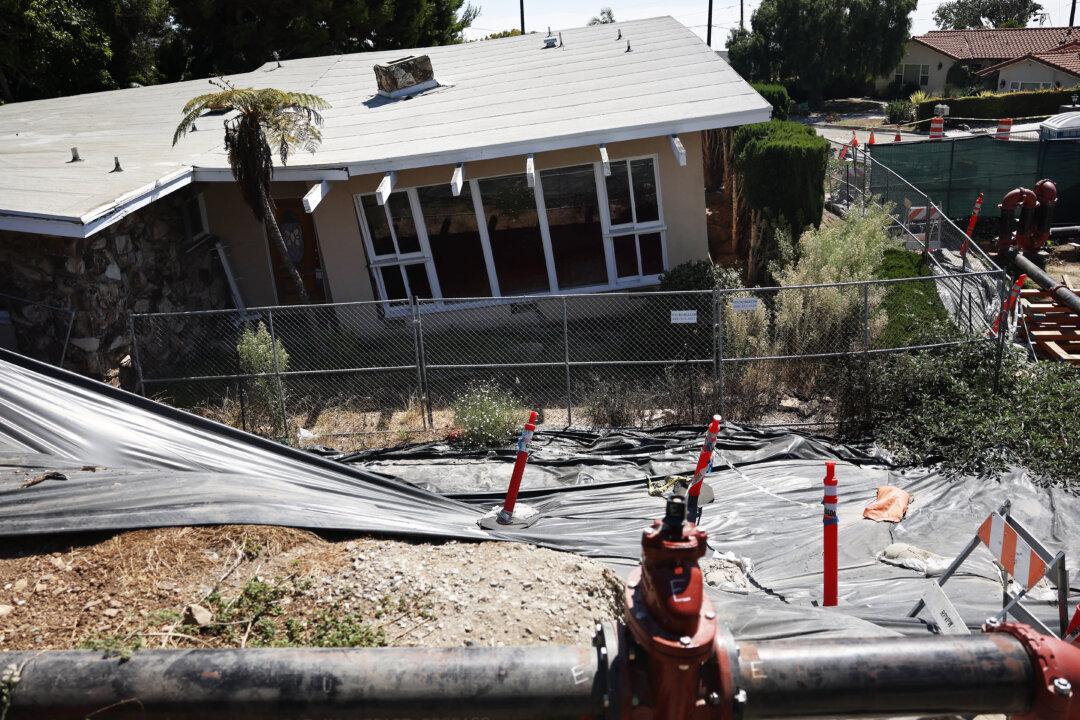In a small enclave of coastal Los Angeles County, city officials have declared an “all hands on deck” effort to steady the land, which is moving at an alarming rate.
A landslide is creating unsafe conditions for hundreds of residents who have had their gas and electricity shut off, with California Gov. Gavin Newsom recently declaring a state of emergency for the area.
At issue are five adjacent landslide areas—known as a complex—about a mile across and encompassing 680 acres. Four are in the most recently affected city of Rancho Palos Verdes and the fifth is in nearby Rolling Hills. According to experts, it is the largest landslide complex in North America.
Since 1956, the land has moved a somewhat sustainable five feet per year. But after recent back-to-back wet winters, parts in some areas began shifting 50 feet a year, or about one foot per week, both horizontally and vertically.
As a result, homes are sliding, huge chunks of roads and land are cracked, buckled, or sinking, and utility lines are stretching and snapping.
The unprecedented movement became especially problematic for some area homeowners at the end of July, when SoCalGas cut service to 135 homes in what’s known as the Portuguese Bend neighborhood of Rancho Palos Verdes.
Since then, between 500 and 600 homes in the direct landslide areas—and in adjacent areas that use the same utility lines—have also had gas and now electricity shut off, as providers fear the land movement might ignite a gas leak or create a downed power line spark resulting in fire.
“If you can imagine your home and how many things actually run off both gas and electric power, it’s pretty much everything,” Rancho Palos Verdes Mayor John Cruikshank told host Siyamak Khorrami on a recent episode of EpochTV’s “California Insider.”
Over the last two months, some have left, while most—many of whom are seniors who bought their homes in the 1960s or 1970s and cannot afford to purchase elsewhere—have stayed and are buying generators and propane tanks, installing solar panels, and hoping to wait out the situation until there is a fix.
“We’re in crisis,” Cruikshank said. “I think a lot of people don’t realize … it’s not a bunch of rich fat cats that are living out there. … It’s actually a really dire situation for many of those families,“ adding that the residents’ home values have ”diminished to almost nothing now.”
Meanwhile, the city has been looking for solutions to stop the movement, hoping this upcoming winter will not be as wet as the last two. In 2023, the area saw normal rainfall double, while this last winter experienced 176 percent of usual precipitation.
Newsom’s declaration of an emergency earlier this month will help get disaster funding—including federal dollars from FEMA—to the area. And Los Angeles County Supervisor Janice Hahn also freed up $5 million from county coffers, also earlier this month, in response to the disaster.
Meanwhile, the city has been reaching out to experts for help and is preparing for what they say should not be another heavy rainy season.
But Cruikshank said the city is not taking its chances.
“Nobody can predict Mother Nature,” Cruikshank said. “I think we need to assume the worst ... and plan for the worst.”
“Nobody can predict Mother Nature,” he said, adding that officials should both assume the worst and “plan for the worst.”
Tactics the city will deploy include taking as much water out of the ground of the affected areas as possible, a process known as dewatering. According to experts, too much underground water creates pressure, which triggers landslides.

An aerial view of damage from ongoing land movement in the area that has caused an electricity shutoff in Rancho Palos Verdes, Calif., on Sept. 3, 2024. Mario Tama/Getty Images

A sign reads, 'Road Closed Landslide Damage' amid an ongoing land movement crisis in the area that has forced power shutoffs to homes, with California Gov. Gavin Newsom declaring a state of emergency in Rancho Palos Verdes, Calif., on Sept. 3, 2024. Mario Tama/Getty Images
Also, funding will be used to find an engineering solution for the area’s buckling roads—like the heavily traveled Palos Verdes Drive South. To date, the city has been spending $3 million a year on temporary solutions like patching and repaving.
The movement beneath the street has created cracks, separation, and peaks, and if you drive on it, Cruikshank said, “there’s an area we affectionately call ‘the ski jump.’”
He also said that after reaching out to Elon Musk—who maintains engineering staff in a range of industries—he quickly heard back and within a week had a meeting with six Musk-hired engineers and executives.
One Tesla employee who lives near the affected area presented solutions and some funding options, Cruikshank said.
Why Build There?
Since the issue became a crisis this year, some have wondered why homes were allowed to be built in the area in the first place.According to Cruikshank, some were constructed well before the city was founded in 1973. Later, property owners successfully sued the city to build in some areas after authorities had denied them permits based on safety concerns related to possible landslides.
“They convinced a judge that it would be safe to build out there,” he said. “We were forced to process their housing permits in those areas.”
Additionally, mapping had shown some other areas were at risk for movement, but nothing of significance had occurred in the last handful of decades, until the most recent rains.
He said the city is going to do whatever it can to help stabilize the situation.
“And then once that happens, we’re going to rebuild [the] community. We’re not going to stop until [it] gets back to normal,” he said.
The Prehistoric Roots
Also featured in the EpochTV episode was Michael B. Phipps, a geologist who has been studying the issue. Phipps told Khorrami the complex of landslides is much deeper than initially thought and is moving and expanding at “unprecedented rates.”“We’re talking about a square mile of area that is moving into the ocean basically.”
Phipps said that during prehistoric times, the Palos Verdes Peninsula was an island that through rising land, changing sea levels, and ocean erosion, ultimately became attached to the California coastline.
After that, about 700,000 years ago, the south side of the peninsula started experiencing landslides as a result of further erosion, wave action, and rainfall that built water pressure underground.
“That’s what started this sliding in the prehistoric times, hundred of thousands of years ago,” he said.
He said during modern times, dewatering has been available as a solution, but the movement will start up again during periods of heavy rain.

The Wayfarers Chapel in a landslide-prone area following its closure due to land movement after heavy rains in Rancho Palos Verdes, Calif., on Feb. 16, 2024. Patrick T. Fallon/AFP via Getty Images

An aerial image shows vehicles driving on a damaged section of road past the Wayfarers Chapel in a landslide-prone area following its closure due to land movement after heavy rains in Rancho Palos Verdes, Calif., on Feb. 16, 2024. Patrick T. Fallon/AFP via Getty Images
After the last two years of precipitation soaking the area, hikers along the area’s trails first alerted authorities about fissures—as wide as six inches—crossing trails, according to Phipps. Then came calls from residents noting fissures in streets.
He said geologists started mapping these events and then realized their significance.
“We realized this is all connected. It’s a much bigger landslide,” he said.
Ramzi Awaad, who manages the Rancho Palos Verdes public works department, said during the episode that utilities that have stopped service say they plan to restore it if the land movement is slowed to an acceptable level.
He also emphasized the importance of dewatering to relieve pressure and that the city is finalizing what he called a winterization plan that will help properly divert rainwater into the ocean instead of letting it go underground.
“This is very much an all-hands-on-deck” engineering fix, he said.






